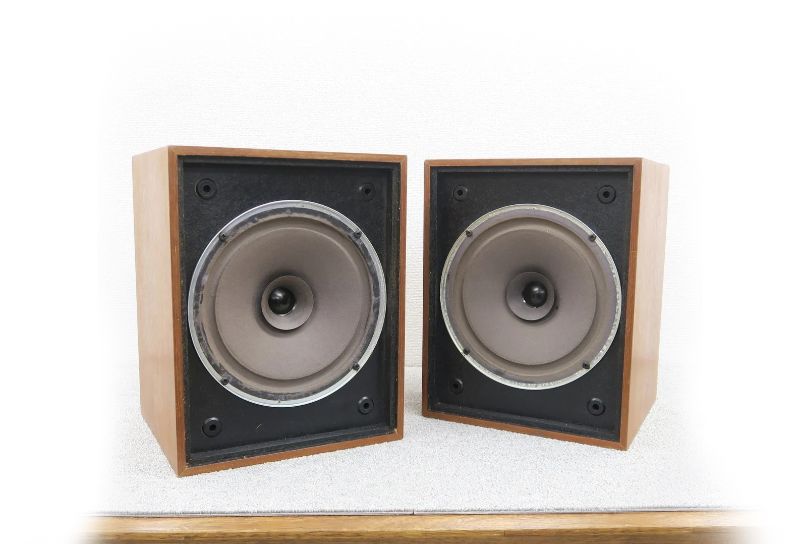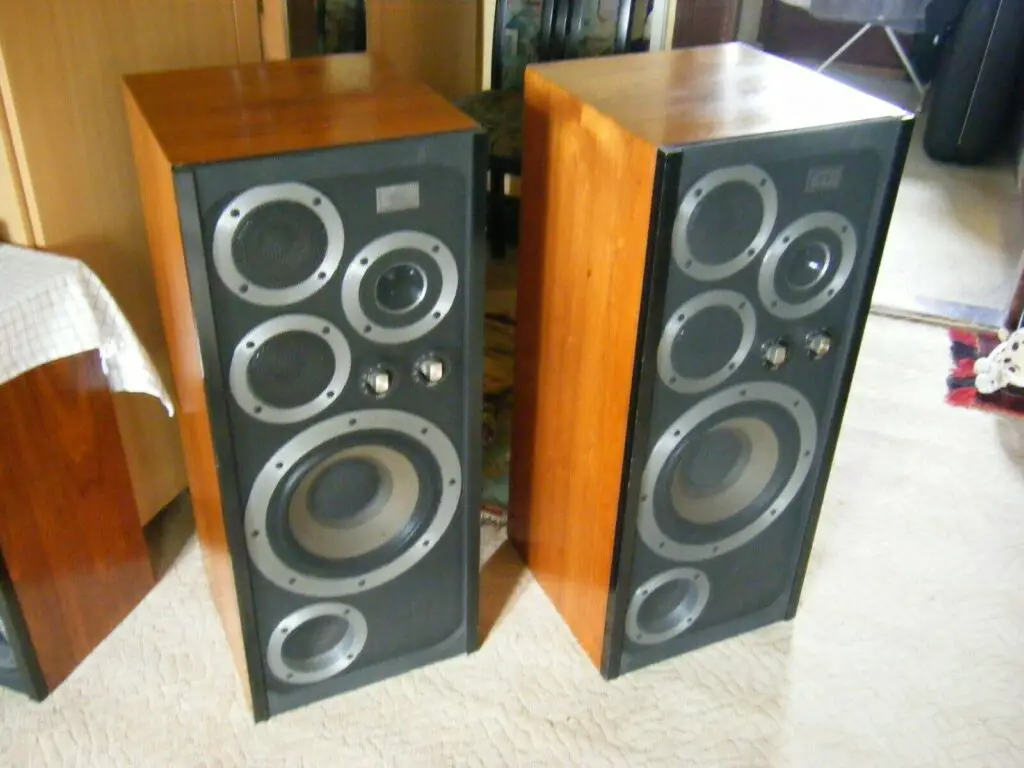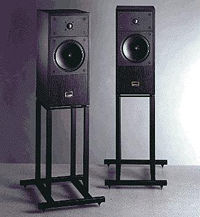The decade of the 1970s was a fascinating one for loudspeakers. Although most designs from that era were rudimentary, there were still some stunning boxes on the market that utilized cutting-edge technology. Indeed, there was a far wider technological gap between commonplace items and cutting-edge ones back then – basic speakers weren’t that different from what you’d see in the 1950s, whereas the best aren’t far off today’s top designs.
The ordinary audiophile of the time would probably end up with a pair of two-way Wharfedale Dentons or something like, and consider it a good investment of fifty pounds. Meanwhile, genuine audiophiles would consider a three-way to be the mark of hi-fi respectability, because after all, isn’t that what professional sound engineers use? A few high-end hi-fi purchasers – think rock gods, movie stars, or oil magnates – might have four-way loudspeakers with built-in supertweeters, but they were few and far between. In the grand scheme of things, the Sony SS-5050, which cost a cool £800 (RRP) per pair in 1976, was well at the top of what mere mortals could buy.
Aside from price, one of its main roadblocks to commercial success was popular belief at the time that Britain made the best loudspeakers. We used to think they had a “nice tone” — a self-fulfilling prophecy, because it was the one we were used to! We had prestigious names like KEF, Tannoy, Celestion, and IMF, as well as a new crop of BBC speaker makers like Chartwell, Rogers, and Spendor, all creating boxes with the same (often KEF) drive units inside. What chance did this upstart company, which was best known for transistor radios and television sets, have?
Despite the fact that Japanese hi-fi was selling in great quantities by this time, there was still a lot of elitism around it. Many audiophile product owners would not allow “Jap trash” (as it was dubbed) in their homes because it was despised by people who didn’t possess it. They had no idea how quickly Japanese products were evolving, or how much money the manufacturers would have to spend on research now. By contrast, much British food was developed along cottage-industry lines — sometimes even in old World War II Nissin huts!
As a result, there was a parallel audio universe: British businesses tended to sell their wares through specialist hi-fi dealers, who, in turn, didn’t offer much (if any) Japanese gear. If you wanted this, ‘sir’ was told to leave the dealer in a timely manner and go to the next Lasky’s, Dixons, or Comet, where he could find something more to his liking. Even hi-fi journals adopted this strange form of audio segregation — some titles catered to Hitachis and Sanyos, while others covered Lecson, Cambridge Audio, Linn, and Naim, and the two never met. Basic audio customers would bemoan the exorbitant prices demanded by British expert hi-fi dealers, while the latter would silently mock the earlier.
Unfortunately for Sony, the SS-5050 fell right into this chasm: it was marketed as a mass market Japanese speaker yet was extremely pricey and encroached on high-end British speaker territory. Spendor BC1s and KEF 104abs may be heard in your local specialist hi-fi store, but the odds of locating this high-end Sony were little to none. As a result, the SS-5050 – along with a slew of other high-end Japanese products – became effectively “hidden in plain sight.” Despite the fact that they were publicly available, few individuals were aware of them. The fact that British hi-fi journals of the time were typically apathetic to Japanese high-end wares at best, and contemptuous at worst, didn’t help matters. They’d make a big deal out of relatively simple speaker drive unit materials like Bextrene, while ignoring Sony’s flagship loudspeaker’s futuristic carbon fiber-treated drive units.
The Sony’s exorbitant price was not entirely due to import duties. Even though the value of the Japanese Yen in relation to the British Pound was three times lower at the time, the SS-5050 sold for more than most high-end British boxes. Its battleship design, as well as the technology inside, mirrored this. Sony was a massive firm with global interests and plants in a number of far Eastern countries at the time. It had a large R&D budget compared to the usual British specialty hi-fi firm, and it produced not only audio but also perhaps the best televisions and video recording/playback equipment in the world.
The SS-5050, like every other top-of-the-line product from this business, was created without compromise and was astonishingly complicated for a 1970s speaker. The three-way design weighed 20 kilograms each box, which was a lot for its 365x630x318mm size. Despite its size, it is effectively a standmounter, needing a real frame stand (think Linn Isobarik) rather than the spun chrome thing on castors on which it was frequently found. A 25mm cone tweeter, a 35mm midrange driver, and a 300mm woofer were all designed and manufactured by Sony and housed inside its large, well-braced beech-ply cabinet. The two higher drive units had special coverings that helped with dispersion, but the enormous twelve-inch bass unit didn’t need any help! All three were bolted onto the front baffle’s large, thick wood and had their own air-tight gaskets.
By the mid-1970s, the Sony Corporation had developed a strong interest in materials science. Of course, by that time, their top integrated turntable, for example, had a carbon fiber armtube, so it was well aware of the advantages of low bulk and rigidity in hi-fi applications. The bass driver cone for the SS-5050 was a carbon-fiber/paper hybrid (which Sony dubbed ‘CARBOCON’); it was a technology that Sony was quite proud of, and it appeared in all of its future high-end speakers. (The SS-5050’s successor, the SS-G7, sold 20,000 pairs worldwide, a remarkable number for such a pricey speaker.) All drive units had diecast frames and high-quality wiring connectors, and the midband and treble drivers were also carbon coated.
At 800Hz and 8,000kHz, the drivers crossed over, making the midband driver the star of the show, keeping its breakup areas well away from the human ear’s most sensitive range of 2-5kHz. The result was a claimed frequency response of 40Hz to 20kHz (-3dB), which was an exceptional achievement at the time. By today’s standards, the SS-5050 had an incredibly high power handling capability. When a typical budget box would be destroyed by anything more than 25W RMS, the Sony needed 80W to be destroyed. It had an impedance of 8 ohms and a very high sensitivity of 91dB/1W/1m for a three-way speaker from the 1970s. This was a fantastic achievement, especially considering the 73 liter cabinet had a sealed infinite baffle design – especially when you consider that most seventies speakers were ridiculously power hungry.
Hearing a well-preserved pair of Sony SS-5050s, four decades after they originally appeared in British stores, is intriguing – but you might be shocked at how current they sound. The speaker’s infinite baffle cabinet and lightweight, high-power drivers produce a quick, tight, punchy sound that is significantly less colored than most speakers of the era. We’re always told that narrow baffles are better for image, but in this case, these Sonys perform equally as well as a pair of much smaller bookshelf boxes. The bass, which flashes on and off like a flashing LED, is what really stands out. There’s no smearing or slurring of bottom notes as you’d get from a reflex ported speaker, which is aided and abetted by the box’s obvious solidity and rigidity. Even at high volume levels, it interferes with the music only slightly, despite its vintage appearance.
If there’s one modern loudspeaker to which it may be compared, it’s ATC. Surprisingly, this business favors sealed cabinets and large three-way speakers, and the Sony is a textbook example of the latter. Its ability to move air rapidly and quietly, combined with a forceful punch when needed, is genuine monitor territory. Despite this, the large Sony sounds nothing like the BBC designs of the time, which used Bextrene cones, or the (then) ultra-modern polypropylene coned Mission 770, which debuted a year or two later. Carbocon isn’t a gimmick, despite what its goofy Japanese-English name might lead you to believe. When you play some well-recorded era rock music through the SS-5050, such as Neil Young’s Southern Man, you’ll be amazed by how dry, sharp, and clean it sounds. Its cup never overflows with tonal warmth or euphony, as it does with much Japanese high end.
Indeed, this large Sony speaker is great in some ways, but play some really deep and delicious sounding Isaac Hayes music – in the form of Bumpy’s Lament – and you’ll quickly notice that something is lacking. The SS-5050 sounds dry and analytical, despite being one of the great classic Stax recordings of the 1970s, with a riot of strings, brass, and flutes. Sure, it’s clean and composed, with no harshness or grit, but it’s a little too forensic and antiseptic to really draw the listener in. The Sony excels in the hi-fi components of the music, propelling the beat forward, delivering dramatic dynamic peaks, and delivering a satisfying low-end wallop, but it comes off as a little cold to these English ears.
The SS-5050 was the top of Sony’s 1976 range when it was released in Tokyo, Japan, in October 1975. It was the first in a series that included the SS-1050, SS-2050, and SS-3050 (four is an unlucky number in Japan, hence its omission). The 3050, which features Carbocon cones and a single (treble) level control, is also worth looking for if you want a taste of the 5050. In recent years, prices for the SS-5050 have ranged from roughly £90 to £300 per pair; due to their relative scarcity, you merely have to wait for a pair to pop up in the classifieds and pay close to what the buyer is asking. They haven’t yet been taken by merchants with creative imaginations, unlike many other products on eBay. In a bizarre exercise in avarice and wishful thinking, certain Japanese high-end devices that used to cost £100 are now being promoted for £1,000 or more, yet the SS-5050 remains reasonably priced and affordable.
Buying any old speaker secondhand is a gamble, which is why it’s always a good idea to try before you buy; if required, bring your own amp and source, and turn up the volume while they’re still cold to listen for any unwanted buzzes or booms. If you hear something like that, you have the option of walking away or making a much lower offer in the hopes that another set of ‘spares or repair’ speakers may appear in a few months. A squirt of Servisol works wonders on the contacts within the treble and midrange level pads, so it’s always worth doing before any more major surgery. It doesn’t hurt to adjust the driving units in the front baffle and clean the back terminals after you’ve obtained a decent pair. After that, some 20-cm-off-the-ground tubular steel frame stands will help them shine.
Sony SS-5050s were sold in more numbers in the UK than you may suppose, therefore they’re still available secondhand and reasonably inexpensive. It’s an unusual ‘time warp’ transducer – not the best or even the most seductive to listen to, but nevertheless a fascinating reminiscence of a long-forgotten hi-fi era. Although Japanese high-end isn’t widely available in the United States, it persists, much like early Lexus saloon vehicles, in performing a very decent job!







